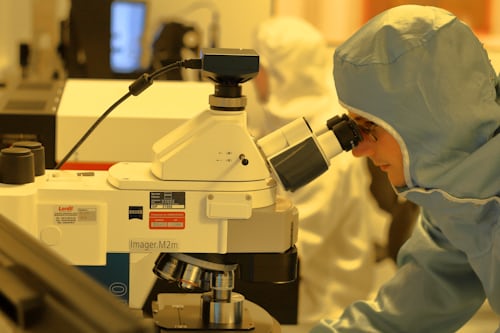
In healthcare environments, cleanliness and the need to avoid contamination are crucial. If hygiene is not completely regulated, the presence of germs and other microorganisms will raise the threat of infections and pose a safety risk for patients.
Besides pathogens, air pollutants can also affect how well the device works by accumulating on a medical gadget’s tiny components. Creating these items in a regulated atmosphere (like a clean room) ensures cleanliness and hygiene.
The worldwide clean room technology market was worth USD 4.0 billion in 2020 and is predicted to grow at a compound annual growth rate (CAGR) of 5.4% between 2021 and 2028.
How Do Clean Rooms Work?
A clean room is a room that has been specifically made to keep out air contaminants and pathogens. It is a unique space, usually found within a manufacturing plant, with specialized filtration designed to get rid of airborne pollutants, including dust, germs, and aerosol particles.
Electronics, pharmaceuticals, and medical device makers frequently employ clean rooms to develop their products. Softwall clean rooms manage temperature, air movement, and humidity in addition to maintaining cleanliness and preventing contamination, all of which can have an influence on the quality of completed goods.
A clean room often lacks windows and other entryways besides doors to let air into or out of the space. ISO 4644-1 clean room standards explain the permissible number of particles, particle size, and HEPA-filtered airflow changes per hour that satisfy ISO-4, ISO-5, ISO-6, ISO-7, and ISO-8 standards.
It is based on cubic meter measures. It correlates to the Fed Standard 209E in the United States, which is based on measurements per cubic foot. The comparable Fed Standard 209E classes are 10, 100, 1000, 10k, and 100k.
The type of medical gadget in issue determines the necessary level of cleanliness. For instance, Class III equipment needs more stringent clean room particle control than a Class I device.
Medical device producers make use of these clean, controlled settings to create and assemble their goods, keeping them free of contamination. It is ensured that germs and pollutants won’t affect the performance or safety of medical equipment by using clean rooms for both medical device assembly and production.
Relevant Medical Device Clean Rooms Rules
Strict rules governing the design, manufacturing, and labeling of medical devices must be followed by businesses that produce them for the medical sector. Regardless of the kind of equipment and how the FDA has categorized it, medical device makers are required to maintain proper cleanliness throughout the production process.
On the other hand, ISO manages cleanliness and contamination control during the development and production of medical items to guarantee patient safety.
The assembly and packing of medical devices are areas where ISO strongly emphasizes cleanliness.
As for product cleanliness, ISO stipulates the following:
- Instruments that organizations clean before sterilizing or using
- Before sterilization or usage, clean any provided non-sterile devices.
- Equipment that cannot be cleaned before use or sterilization
- Devices that require cleaning while in use but are not provided sterile
- Every process agent that needs to be removed from the final product during production
The ISO also specifies rules for pollution control and the workplace environment. The organization must identify and record the workplace environment, working circumstances, and methods for preventing contamination that affects the device’s quality.
Contamination during the post-sterilization stages renders the entire sterilization process useless. In order to maintain the required level of cleanliness throughout the assembly and packing processes following sterilization, manufacturing and supplying organizations are required to specify standards for the control of contamination with microorganisms and particle substances in the workplace.
Why Clean Rooms Matter For Medical Devices?
It is possible to prevent dust and other particulates from contaminating the components of medical equipment by keeping the atmosphere under control in a clean room. If disposable and non-disposable devices are not manufactured in a controlled setting, a substantial risk of possible microbial contamination may arise.
Here are the primary factors that make clean rooms so crucial for the production and assembly of medical devices:
Licensed Facilities
Clean room construction businesses that have been certified to adhere to stringent criteria and specific restrictions from certain authorities. By creating and employing these regulated facilities, it will be possible to ensure hygienic conditions throughout the production of every medical equipment.
Rigid Protocols
Since the COVID-19 pandemic, manufacturing in a sterile environment has been more crucial than ever, It can ensure the ongoing manufacture of medical devices during a pandemic.
Training of Staff
Professionally qualified personnel are required for the creation and implementation of clean rooms. Medical manufacturing companies must contract clean room service providers with qualified staff to maintain cleanliness throughout the development and installation processes.
To guarantee the safe manufacture, distribution, and use of some disposable and non-disposable medical items, businesses in the medical manufacturing sector need clean rooms. Those requirements may be met by using sterile areas, adhering to stringent processes, and meeting controlled ISO standards by a reputable medical device manufacturer that offers clean room manufacturing.
Since integrating a clean room for medical device operations into a facility may be highly expensive, firms may find it advantageous to outsource the production of medical devices to a licensed contract manufacturer.
